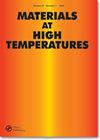Cr对多晶镍基高温合金氧化行为的影响
IF 0.9
4区 材料科学
Q4 MATERIALS SCIENCE, MULTIDISCIPLINARY
引用次数: 0
摘要
研究了两种不同Cr含量镍基高温合金在700 ~ 800℃温度范围内的等温氧化行为。体重变化曲线表明,随着温度的升高,体重减轻幅度增大,相对较低的Cr比对应的体重增加速率较慢。显微观察发现,氧化渗透主要沿晶界进行,特别是低铬合金,渗透深度与氧化温度密切相关。利用能量色散x射线能谱和x射线光电子能谱分析了两种合金的氧化机理。本文章由计算机程序翻译,如有差异,请以英文原文为准。
Effect of Cr on the oxidation behaviour of polycrystalline nickel based superalloys
ABSTRACT Isothermal oxidation behaviour of two nickel base superalloys with different Cr contents was investigated in the temperature range of 700–800 °C. Weight–change curves show that weight loss increases with increasing temperature and a relatively lower Cr ratio corresponds to slow weight gain rate. Microscopic observations uncover that oxidation penetration attacks the alloys primarily along grain boundary especially for the lower-Cr alloy, and the penetration depth is strongly dependent on the oxidation temperature. The underlying oxidation mechanisms of the two alloys are explained using energy-dispersive x-ray spectroscopy and X-ray photoelectron spectroscopy.
求助全文
通过发布文献求助,成功后即可免费获取论文全文。
去求助
来源期刊

Materials at High Temperatures
工程技术-材料科学:综合
CiteScore
1.90
自引率
15.40%
发文量
58
审稿时长
>12 weeks
期刊介绍:
Materials at High Temperatures welcomes contributions relating to high temperature applications in the energy generation, aerospace, chemical and process industries. The effects of high temperatures and extreme environments on the corrosion and oxidation, fatigue, creep, strength and wear of metallic alloys, ceramics, intermetallics, and refractory and composite materials relative to these industries are covered.
Papers on the modelling of behaviour and life prediction are also welcome, provided these are validated by experimental data and explicitly linked to actual or potential applications. Contributions addressing the needs of designers and engineers (e.g. standards and codes of practice) relative to the areas of interest of this journal also fall within the scope. The term ''high temperatures'' refers to the subsequent temperatures of application and not, for example, to those of processing itself.
Materials at High Temperatures publishes regular thematic issues on topics of current interest. Proposals for issues are welcomed; please contact one of the Editors with details.
 求助内容:
求助内容: 应助结果提醒方式:
应助结果提醒方式:


